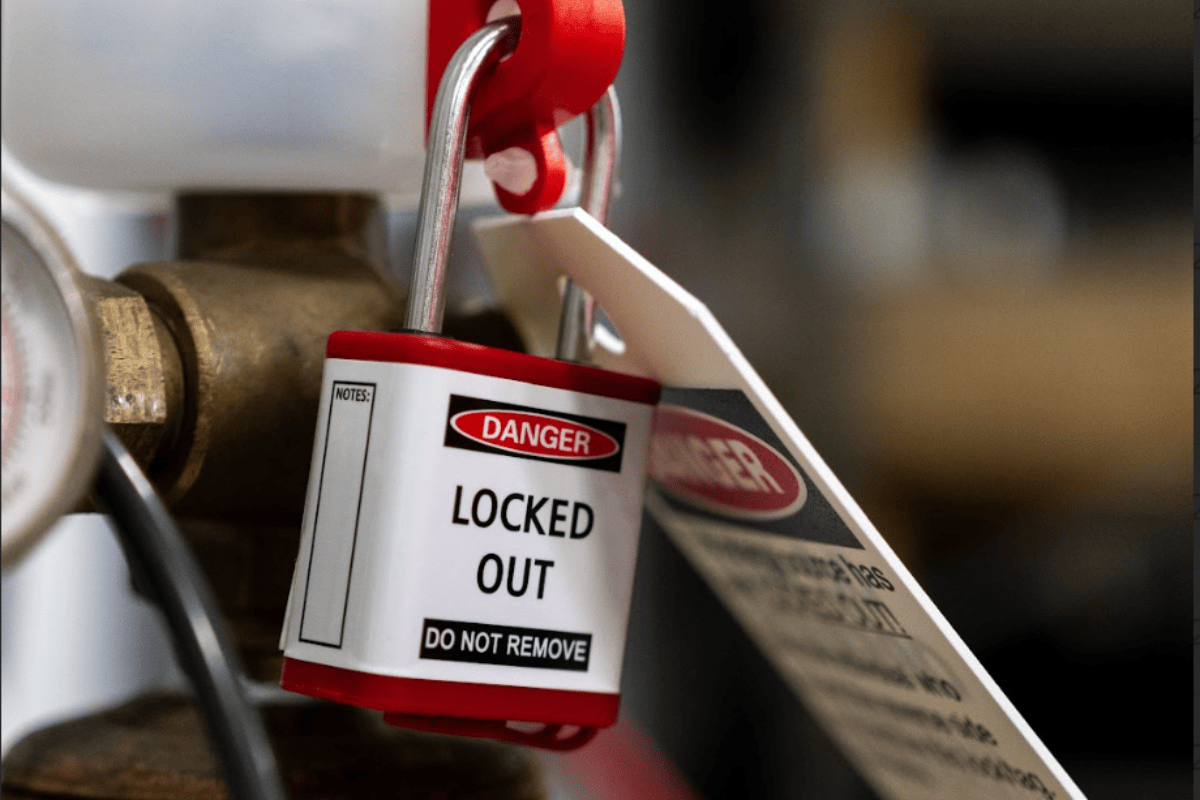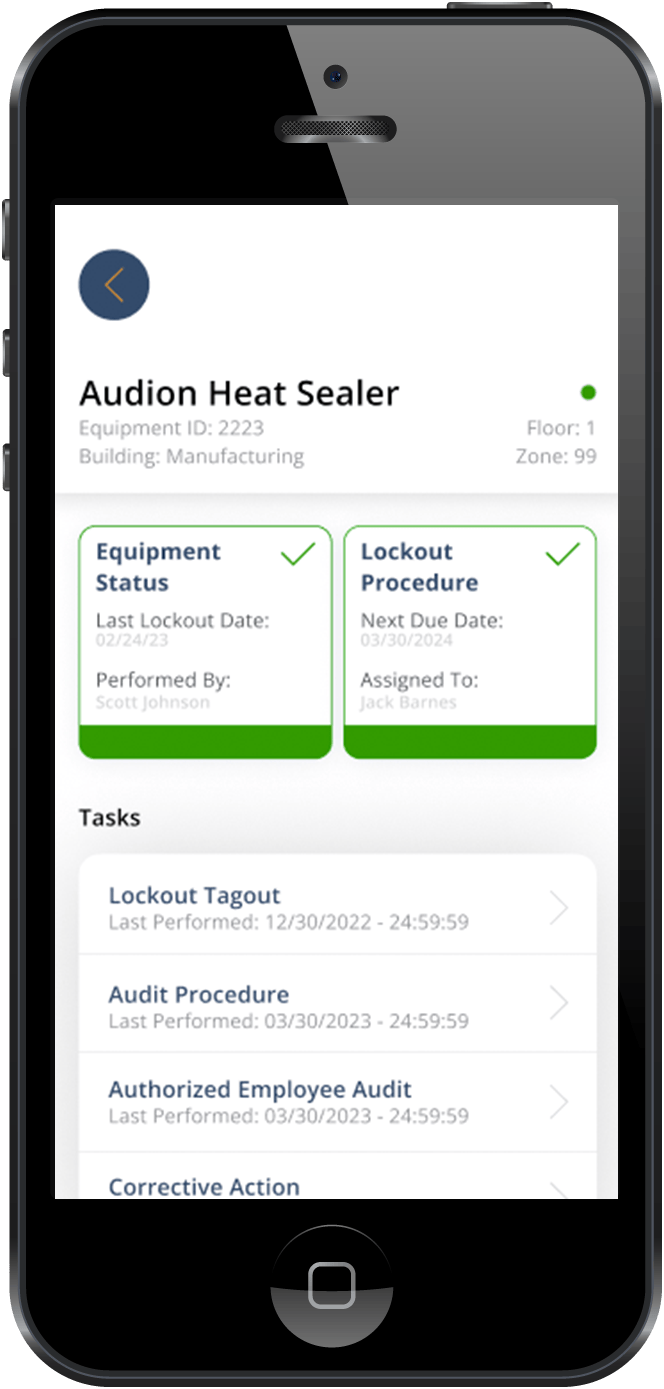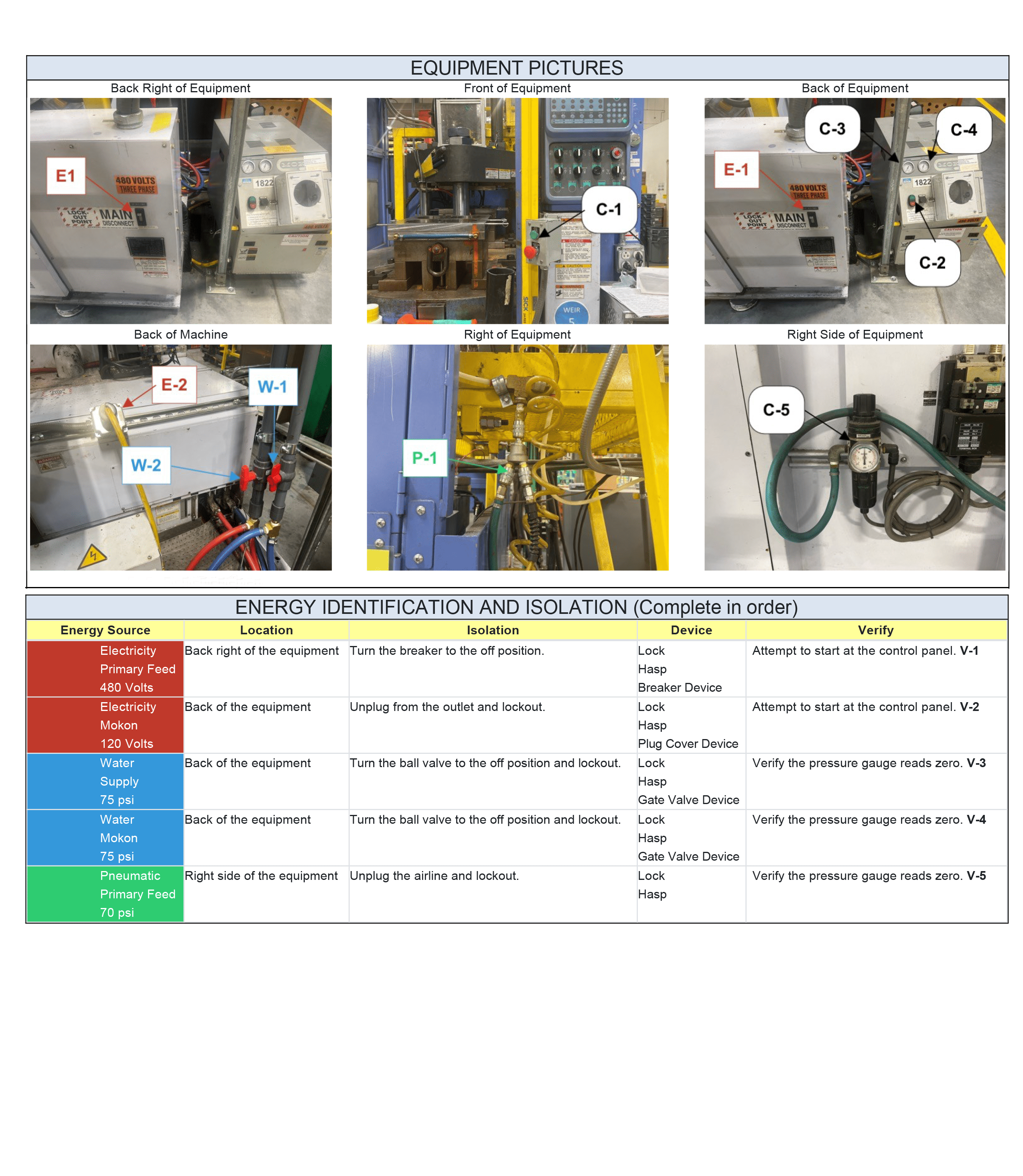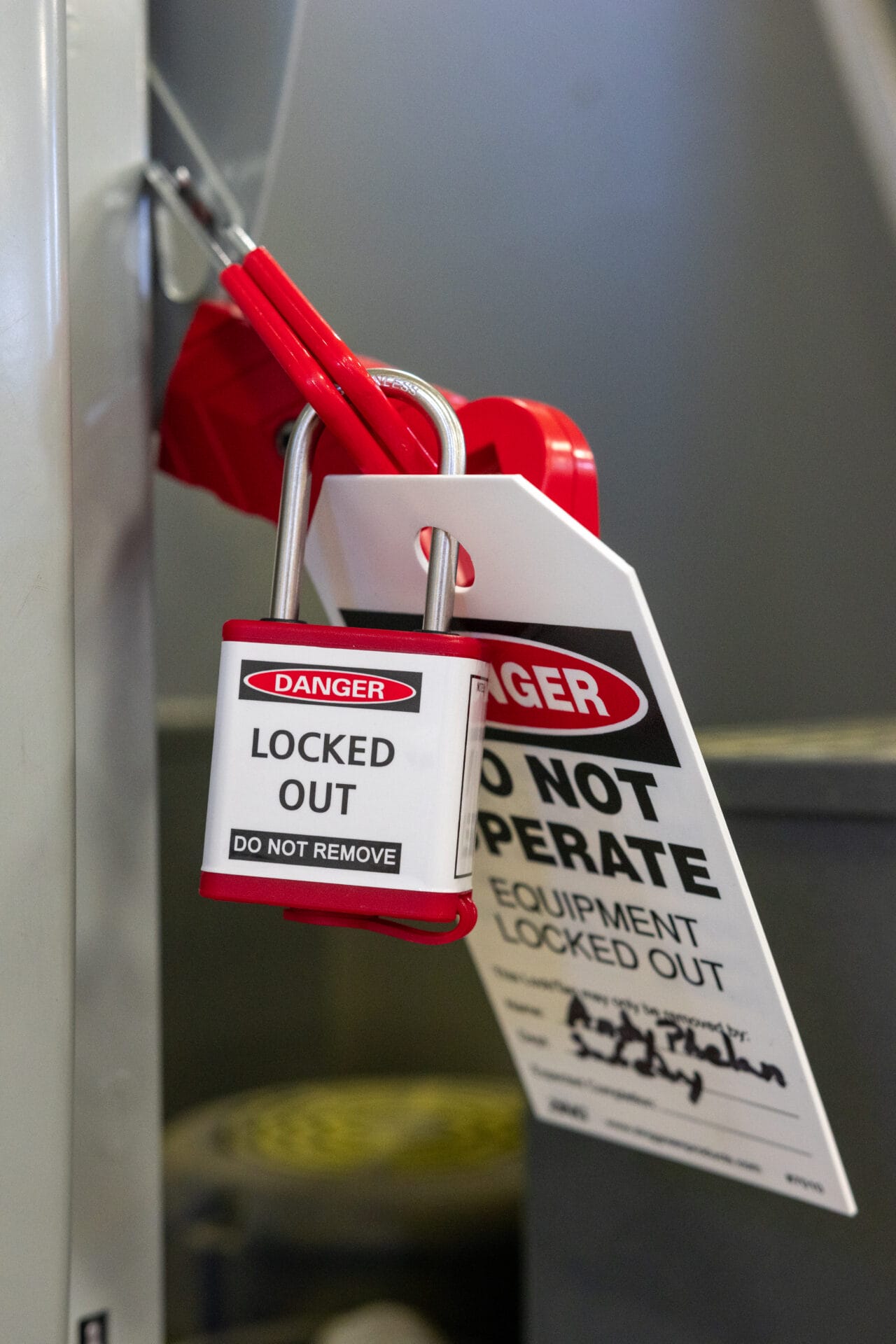In this article we will explore ANSI Z244.1, a regulation regarding the control of hazardous energy (lockout tagout) and what is significant about it.
Workplace safety is a matter of prime importance. Because of this, organizations such as the American National Standards Institute (ANSI) have established regulations and standards to promote safe environments for workers.
Among these regulations, the Control of Hazardous Energy (ANSI Z244.1) stands out as a vital part of encouraging safe practices when working with machinery and equipment.
This article aims to explain the ANSI Z244.1 standard, its key components, and the consequences and benefits that can come with compliance to it.

ANSI Z244.1 – lockout tagout – control of hazardous energy
What Is ANSI?
ANSI is an acronym that stands for “American National Standards Institute”. ANSI is a US-based organization that oversees the development of voluntary consensus standards. Essentially, they are a non-government group that is helping establish and regulate best practices for work safety. They were first established in 1918 and have since gotten over 13,000 approved American Nations Standards (ANS) including the one we are focusing on today: ANSI Z244.1.
What Does ANSI Z244.1 Regulate?
Intro: The American National Standards Institute (ANSI) standard Z244.1, also known as the “Control of Hazardous Energy – Lockout/Tagout and Alternative Methods,” is a critical guideline for ensuring the safety of workers who maintain and service machinery and equipment. This standard provides comprehensive requirements and best practices for controlling hazardous energy, thereby preventing accidental energization, which can lead to severe injuries or fatalities.
Purpose: The primary objective of the ANSI Z244.1 standard is to establish requirements for the control of hazardous energy during the servicing and maintenance of machines and equipment. It aims to protect workers by preventing unexpected energization, start-up, or release of stored energy that could cause harm.
Scope: The standard applies to all industries where servicing and maintenance activities involve the potential for exposure to hazardous energy. It covers various energy sources, including electrical, mechanical, hydraulic, pneumatic, chemical, thermal, and other energy forms.
Key Components of this “Control of Hazardous Energy” Safety Standard
Now, let’s dive a little deeper into the key information that is provided in ANSI Z244.1.
Energy Control Program:
- Explanation: The standard mandates the development and implementation of an energy control program, which outlines the procedures and practices for safe lockout/tagout (LOTO) of machinery and equipment.
- Regulations:
- Organizations must establish written procedures for controlling hazardous energy.
- The program should include specific steps for shutting down, isolating, blocking, and securing machines to control hazardous energy.
- Procedures must be tailored to the specific machinery and equipment used in the workplace.
Training and Communication:
- Explanation: ANSI Z244.1 emphasizes the importance of training and communication to ensure that all personnel understand and can properly implement LOTO procedures.
- Regulations:
- Employees authorized to perform LOTO must receive comprehensive training on the specific procedures and the hazards associated with the energy sources they will control.
- Affected employees, who work near the machinery but do not perform LOTO, must be informed about the procedures and their purpose.
- Periodic retraining is required to maintain and reinforce employees’ knowledge and skills.
Periodic Inspections:
- Explanation: Regular inspections of LOTO procedures and practices are required to ensure their effectiveness and compliance with the standard.
- Regulations:
- Organizations must conduct periodic inspections at least annually to verify that LOTO procedures are being followed correctly.
- Inspections should be performed by an authorized employee who is not involved in the procedure being inspected.
- Any deviations or inadequacies identified during inspections must be corrected, and employees must be retrained if necessary.
Lockout/Tagout Devices:
- Explanation: The standard specifies requirements for the devices used to lock out or tag out machinery and equipment.
- Regulations:
- LOTO devices must be durable, standardized, and capable of withstanding the environment to which they are exposed.
- Devices should be singularly identifiable and not used for any other purpose.
- Tags used for tagout alone must include warnings against unauthorized removal and clearly state the lockout purpose.
Alternative Methods:
- Explanation: ANSI Z244.1 provides guidance on the use of alternative methods for controlling hazardous energy when traditional LOTO is impractical.
- Regulations:
- Alternative methods may include advanced safety technologies, such as interlocks, control circuit devices, and other engineered solutions.
- These methods must provide effective protection equivalent to traditional LOTO.
- Employers must assess the risks and document the justification for using alternative methods.
Why Does Compliance With ANSI Z244.1 Matter?
Adhering to the ANSI Z244.1 standard is essential for maintaining a safe work environment and preventing accidents related to hazardous energy. It is generally accepted by workers in the US as correct protocol when dealing with hazardous energy.
Here are some steps organizations can take to establish/maintain compliance:
- Develop a comprehensive lockout tagout program tailored to the specific needs and equipment of the organization.
- Ensure all employees receive the necessary training and are aware of the procedures and their importance.
- Regularly inspect and audit LOTO practices to ensure ongoing compliance and effectiveness.
- Utilize appropriate LOTO devices and consider alternative methods when traditional lockout tagout is not feasible.
- Maintain thorough documentation of all procedures, training sessions, and inspections.

Logo for ANSI – creators of ANSI Z244.1
Possible Consequences/Benefits of ANSI Z244.1 Compliance
Ensuring compliance with established standards such as Z244.1 might feel like another item on a long to-do list. Here are some of the reasons that understanding and following this regulation can prove to be beneficial, as well as the natural consequences that may come with non-compliance.
#1 Employee Safety
- Noncompliance Consequence : Death/Harm to Workers
- Employees servicing or maintaining machines or equipment may be exposed to serious physical harm or death if hazardous energy (such as electrical, mechanical, hydraulic, or pneumatic energy) is not properly controlled.
- Accidental energization of equipment or machinery during maintenance, repair, or servicing activities can result in electrocution, crushing, amputation, or other life-threatening injuries.
- Compliance Benefit : Worker Safety and Well Being
- Compliance with the lockout/tagout standards such as ANSI Z244.1 and OSHA 1910.147 help prevent an estimated 120 fatalities and 50,000 injuries each year. These numbers are evidence that efforts towards compliance preserve lives, efficiency, and the overall well-being of the companies.
#2 Workplace Incident Frequency
- Noncompliance Consequence: Increased Incidents
- Failure to control hazardous energy effectively increases the likelihood of workplace accidents and incidents, including equipment malfunctions, unexpected machine starts, and uncontrolled releases of stored energy.
- These incidents not only harm workers directly involved but also pose risks to nearby personnel and may cause damage to property and equipment.
- Compliance Benefit: Decreased Incidents
- Reduced workplace incidents result in fewer injuries/deaths, overall improved efficiency, avoidance of legal issues, and more. Because of this, it is easy to understand why so many companies are willing to invest in their lockout tagout program.
#3 Legal Standing
- Noncompliance Consequence: Fines and Legal Issues
- While non-compliance with ANSI doesn’t necessarily have any legal repercussions, there can be severe penalties and fines for those within the United States who do not comply with OSHA (Occupational Safety and Health Administration) standards.
- On top of that, regulatory agencies may conduct inspections and investigations following workplace accidents. Failure to demonstrate compliance with lockout tagout requirements can lead to significant repercussions.
- Additionally, in the case of an incident, a family may choose to sue if there have been improper steps taken that contributed to the incident occurring. Legal battles such as this can be costly affairs that are well worth avoiding.
- Compliance Benefit: Saved Money
- In general, the costs associated with preventative measures such as maintenance, repairs, and LOTO procedures are much lower than the ones that can be accumulated through non-compliance fines or legal battles.
#4 Operational Efficiency
- Noncompliance Consequence: Decreased Efficiency
- Workers injured on the job from exposure to hazardous energy lose an average of 24 workdays for recuperation. That is nearly 5 work weeks!
- And even in cases that are much less severe, accidents resulting from inadequate lockout tagout procedures can disrupt operations, leading to downtime, production delays, and decreased productivity.
- Equipment damage or malfunction caused by improper maintenance practices further exacerbates operational disruptions and may require costly repairs or replacement.
- Compliance Benefit: Increased Efficiency
- While LOTO procedures could be considered a disruption to operations, they are minor in their time cost compared with the delays that can be accrued due to death or injury from hazardous energy or machinery.
- In fact, these routine inspections can prolong machinery life, help avoid malfunctions, and encourage positive, productive work from employees.
#5 Company Reputation
- Noncompliance Consequence: Damaged Reputation and Brand Image
- Incidents involving worker injuries or fatalities due to failure to implement lockout tagout procedures can damage a company’s reputation and brand image.
- It takes years of consistency and valuable work to develop a strong reputation. However, all that hard work can be undone in an instant with the occurrence of a singular accident.
- With that, negative publicity, media scrutiny, and public perception of workplace safety deficiencies can undermine stakeholder trust and confidence in the organization, impacting its long-term viability and competitiveness.
- Compliance Benefit: Maintained Reputation and Brand Image
- It is much easier to maintain a positive brand image than to repair one that has been damaged. Once trust is lost, it is much harder to regain.
- By focussing your efforts on preventative action, you are safeguarding your institution from the backlash that can ensue from a serious incident. In the event that an accident occurs even with precautions being taken, society will be much more understanding of an organization that was intentional rather than negligent.
#6 Employee Morale/Retention
- Noncompliance Consequence: Fearful and Distrustful Workers
- Workplace accidents resulting from inadequate safety measures can have a profound impact on employee morale, causing fear, anxiety, and distrust among workers.
- High rates of workplace injuries and fatalities may lead to employee dissatisfaction, turnover, and difficulty attracting and retaining skilled talent.
- Compliance Benefit: Trusting and Happy Workers
- Implementing proper safety protocol through Lockout Tagout is a way to communicate to your staff that they are valued. Workers who feel they are safe at work and cared for will be much more likely to stay with the company and praise it even after they leave.
What Happens If You Are Not ANSI Compliant?
Regulations set by ANSI are what are called consensus standards. This means that they are recommendations that have come from a group of experts on the matter, but don’t have any legal authority. Essentially, you cannot be fined for non-compliance with ANSI standards. Therefore, compliance with ANSI standards is voluntary.
However, many of the operating practices and guidelines within ANSI standards are similar to those established by the Occupational Safety and Health Administration (OSHA). Though ANSI may not have any legal authority in the United States, OSHA does. Companies that are found violating OSHA standards may be subject to large fines. To learn more about the various kinds of OSHA violations and the severity of their fines, read our article about OSHA 1910.147. This standard is like the OSHA equivalent to ANSI Z244.1, and is good for anyone working in lockout/tagout to be familiar with.
How Smart Safety Pro Can Help With Compliance
Smart Safety Pro is a mobile software that aids in managing lockout tagout procedures, inspections, maintenance, and programs. Much like the regulations set forth by ANSI, our software is designed to be a tool to help keep your workplace safe.
Here are a few features and benefits that help with compliance:
- Since wifi isn’t required for our software to sync, users can complete reports on the go and get real time updates. This helps all management and team members better collaborate. They can know what tasks have been completed and what still needs to be done.
- Our software provides a centralized data management system that stores and organizes info. This feature can be particularly handy when collecting documents to show during audits and inspections.
- The system is highly customizable with the ability to build your own loto procedures in minutes. This way, as your company changes or regulations evolve, you can grow with them.
These are just a few reasons to integrate software into your lockout tagout operations. Click here to set up a demo and learn more about how Smart Safety Pro can help in your situation.
Conclusion
The ANSI Z244.1 standard provides a robust framework for controlling hazardous energy during the servicing and maintenance of machinery and equipment. By adhering to this standard, organizations can significantly reduce the risk of workplace accidents, protect their employees, and ensure compliance with safety regulations. Understanding and implementing the key components of ANSI Z244.1—such as developing an energy control program, conducting training and inspections, using proper LOTO devices, and considering alternative methods—are crucial steps in creating a safe and compliant work environment. Though ANSI is not a government organization, there are still potential consequences associated with non-compliance. In order to put safety first, companies can turn to lockout tagout software to develop an effective LOTO program. By learning about ANSI Z244.1 and implementing its guidelines, companies are able to invest in the safety of their employees, assets, and company future.






